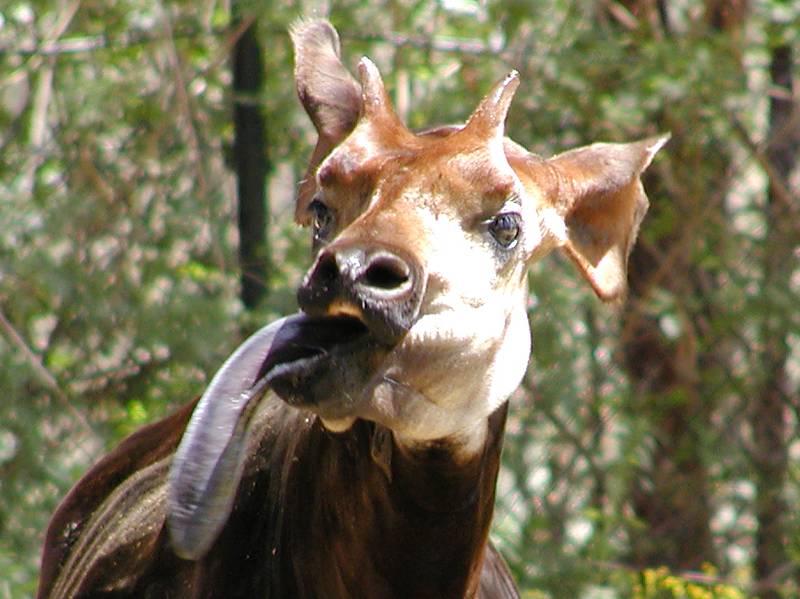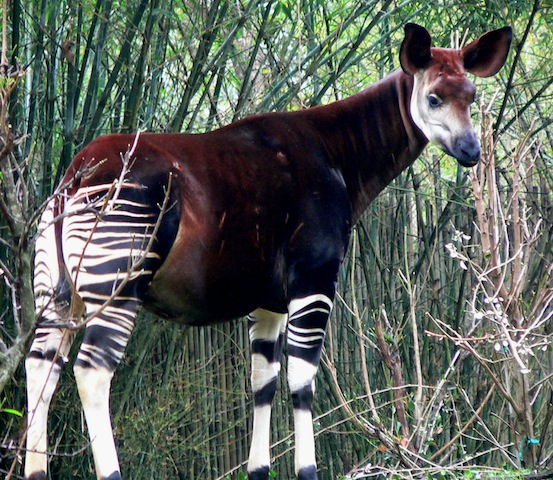
John Lukas, president of The Okapi Conservation Project: ‘The okapi was the last large animal discovered in Africa, in 1901. It was a very mysterious animal, and still is. Very secretive.’
At first glance, the okapi looks like something went terribly awry in the Animal Design Studio: A giraffe head plopped on a dark brown horse body with the rump and legs of a zebra.
Wait, what?
And—get this—upon second glance, this oddity that emerged from the Studio after the construction mishap seems quite beautiful, sort of enchanting.
Curiouser and curiouser. Perhaps the most striking thing about the okapi, though, is that its confounding appearance may not even stand as the animal’s most distinctive trait.
Let’s see, other notable wrinkles in Okapi-Land include its being found in only one small, specific area of the entire world…That its tongue is a mile long. OK, an exaggeration, clearly, but not by as much as you’d think…With its bizarro mien, you’d think the okapi would perennially finish last in any game of Hide And Seek, but it’s virtually impossible to spot one in the wild…it’s not uncommon for an okapi to throw an attacking leopard off its back…
See?
Okapi in the Okapi Wildlife Reserve, Ituri forest, DR Congo. Filmed in March 2007 by WildlifeDirect in Epulu, in Ituri province. The okapi is a male called Karu. Visit www.wildlifedirect.org/okapireserve for more information.
But we may be getting ahead of ourselves. We should probably start with some basics, and we’d be hard pressed to do better for those than asking John Lukas, the president of The Okapi Conservation Project, a nonprofit organization founded in 1987 that operates in the Democratic Republic of Congo (DRC) to protect the natural habitat of the okapi.
“The okapi is really a forest giraffe,” Lukas explained in a December 18 interview on Talking Animals. “There’s only two species in the giraffe family: the savannah giraffe that we’re used to seeing, with the very long neck, and the okapi is a forest form.
“Their food sources are much closer to the ground, so there’s no need for a really long neck. They’re basically very similar, but they’ve been separated for a long time, evolutionarily, but they’re in the same family.
“The okapi was the last large animal discovered in Africa, in 1901. It was a very mysterious animal, and still is. Very secretive. So when the first signs of them came out, in the early 1900s, people were very fascinated by them.
“And there was a big rush to bring specimens into museums and to zoos, because they were thought to be such a unique animal, with stripes like a zebra and a different head and the coloration. And they’re quite large. The females can be 800-plus pounds, the males around 600 pounds—so very big animals.”

If you’ve got it, flaunt it: an okapi shows off its 18-inch tongue. ‘The okapi can reach every bit of their body with their tongue, to clean itself. They groom themselves on a regular basis.’
So when you describe the okapi as “secretive,” what do you mean by that?
“Well, basically,” he said, “they live in a very dense tropical forest, and a certain belt across the Democratic Republic of Congo, which was Zaire, which was the Belgian Congo. They graze on about a hundred different species of leaves, they don’t use trails, they just kind of walk through this forest, eating. They have a tremendous sense of hearing and smell.
“So before someone even gets close to them, they are long gone. They’re solitary, first of all, except for a mother and calf. And they will always be on alert, at all times. Leopards are their main predators, so they’re always on the alert for strange sounds or noises that a predator may make. Then they move off. And they’re very quiet.”
Intriguing, to be sure. But I think I may know what you’re thinking: How long before you circle back and elaborate on this tongue business you mentioned? Fair enough. Once again, our go-to guy is John Lukas.
“Giraffes and okapi have about an 18-inch-long tongue. What’s pretty unique about the okapi is they can reach every bit of their body with their tongue, to clean themselves. They can turn and twist—they groom themselves on a regular basis. They stay very clean.
“They have a very beautiful dark brown, almost black, coat that’s like velvet. They constantly keep themselves in good condition—that’s mainly to help as an insect repellant, to keep insects from getting on them.
An okapi in a quiet moment in its natural habitat. Speculation on the animal’s existence began with popular press reports covering Henry Morton Stanley’s journeys in 1887. Remains of a carcass were later sent to London by the English adventurer and colonial administrator Harry Johnston and became a media event in 1901.
As if the tongue marvel isn’t boggling enough, Lukas seems to be sketching a scene resembling the one you might see when your cat is grooming himself in the living room.
“Right,” he affirmed, “they can reach their ears, they can flick the tongue all over the place. But the tongue’s real purpose is to wrap around a bunch of leaves and pull them off the stem and into their mouth.
“This way they can wrap around several times, get a good grip, and then, with a quick jerk of the head, they tear all the leaves off, and then swallow them. They’re ruminants, so they would chew their cud later on, to help digest the nutrients in the food.”
At this point, I think calling the oan eccentric critter lands squarely in understatement territory. (Dense, tropical understatement territory.)
Still, as we learn more about its behavior and idiosyncrasies, it’s difficult to reconcile an animal spending much of the day grazing across the forest in the DRC (the only place in the world the okapi lives)–even allowing for its keen sense of smell and hearing—and not being charged by a leopard at the first pit stop for a bunch of leaves, given the okapi’s somewhat showy appearance.
With the crazy quilt of physical characteristics, particularly the zebra stripes, you’d think the okapi might as well be wearing a “Kick Me” sign. Or maybe one that reads “Come And Get It, Leopards!”
However, counter-intuitive as this might seem, the stripes serve as a form of camouflage, according to Lukas.
“Yeah, well, I’ve seen it actually happen, when the light dapples to the forest floor, very little light hits the forest floor, so it comes in this dappling streaks. And the stripes on the rump help break up the okapi outline, so they kind of blend in with the environment.”
This may beg the question: If they’re so deft at eluding leopards, why, then, has the okapi population dwindled so precipitously in the last decade?
Toward the end of 2013, when the International Union for Conservation of Nature (IUCN) Red List of Threatened Species released its new list, the okapi had been reclassified as “Endangered.”
On April 27, 2011, at the Brookfield Zoo in Brookfield, IL, an opaki calf was born. In this video, a zookeeper is guiding the calf toward the scale in order to record a daily weight measurement. Opened in 1934 and operated by the Chicago Zoological Society, the Brookfield Zoo has gained an international reputation for taking a cutting-edge role in animal care and conservation of the natural world. Follow this link for more information about the Brookfield Zoo.
This represents the okapi’s move up two positions from its original Red List classification of “Near Threatened” to “Endangered.” Or, in hard numbers, where there were an estimated 40,000 okapi in the wild a decade ago, the population has declined to approximately 10,000 to 15,000 animals today.
No, the leopards have not dramatically stepped up their batting average. Unfortunately, the plunging numbers have nothing to do with animal predators, but with human ones. For one thing, the Democratic Republic of Congress is marred by military strife and widespread violence, rooted in an often-vicious civil war still raging on after many years.
So, okapi can be struck down as collateral damage. Lukas places the violence and widespread weaponry—and the attendant impact on okapi population–in context.
“Going back, we were there in the late ‘80s, early ‘90s, and there was no decline in the okapi population. It was increasing. There was no threat.
From the Frankfurt Zoo, this video shows a male baby okapi making his first public appearance, three months after he was born. The baby okapi, called Maiko, was the first to be born in the Zoo in six years.
“The main threat today is the armed groups that are prevalent in this region. There are two ways they affect wildlife population. First, they prevent effective conservation actions. They stop the guards from going on patrol—it’s too dangerous for the guards. They could get ambushed. You have no chance in an ambush in the forest. So that really limits what the guards can do.
“The second things these armed militia—which are a bunch of thugs—do is they engage in various illegal activities from gold mining to ivory/elephant poaching, logging.
Okapi are very sensitive to changes in the environment, so with these changes, they may move into other areas, and may end up in an area that’s not suitable for them.”
Outside of the Okapi Wildlife Reserve, a sprawling refuge created by the Congolese government in 1992, the okapi roams unprotected against more intentionally sinister forces.
“In other areas, apart from where we work, the animal is poached for its meat, so it is snared. How they’re caught is mainly by snaring,” Lukas said, going on to explain that okapi meat is sold as part of the bush meat trade, although there’s no internal market for it.
There are many poaching efforts underway there—particularly aimed at the region’s forest elephants and other large animals. Traps are set for those animals, and okapi are often caught incidentally.
Yet, despite these dark factors and the disturbing trends, Lukas sounds optimistic about the okapi’s future.
“Now, we’re slowly .coming back,” he said. “I think getting economic development in the area will be the most important thing, helping young people find alternative ways to make a living.
“Okapi are very secretive, but wildlife populations are very resilient—they can come back very strong, given the right conditions. I’ve seen that, and I’m rooting for the okapi.”
Follow this link to the complete Talking Animals interview with John Lukas.


